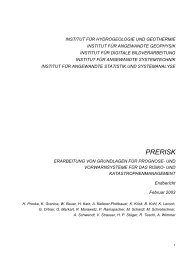Pre-feasibility study for a CDM-AR project in the Cochabamba ...
Pre-feasibility study for a CDM-AR project in the Cochabamba ...
Pre-feasibility study for a CDM-AR project in the Cochabamba ...
You also want an ePaper? Increase the reach of your titles
YUMPU automatically turns print PDFs into web optimized ePapers that Google loves.
In table 5.1 <strong>the</strong> establishment and management costs per hectare per year are given,<br />
<strong>the</strong>se costs don’t <strong>in</strong>clude cost <strong>for</strong> land purchase or opportunity costs.<br />
Table 5.1: Costs of a pure plantation <strong>in</strong> USD per ha<br />
Establishment Year 1 Year 2 Year 3 Year 4 Year 5 Year 6 Year 7 Year 8 Year 9><br />
445 156 184 86 90 70 70 70 70 20<br />
Source: CETEFOR 2005<br />
5.1.3 Th<strong>in</strong>n<strong>in</strong>g<br />
The th<strong>in</strong>n<strong>in</strong>g regime differs per tree specie. Only <strong>the</strong> first th<strong>in</strong>n<strong>in</strong>g, has a cost s<strong>in</strong>ce <strong>the</strong><br />
stems can only be used as fuel wood <strong>for</strong> own use. Cost and benefits are calculated <strong>for</strong><br />
stand<strong>in</strong>g wood, so <strong>the</strong>re are no additional costs <strong>for</strong> <strong>the</strong> farmers. S<strong>in</strong>ce this is not a very<br />
favorable commerce from a farmer’s po<strong>in</strong>t of few, CETEFOR will participate <strong>in</strong> wood<br />
sale and farmers will be tra<strong>in</strong>ed and skilled <strong>in</strong> market<strong>in</strong>g <strong>the</strong> wood products. In this<br />
<strong>study</strong> we based our calculations on actual stand<strong>in</strong>g wood prices paid by <strong>for</strong>est<br />
companies.<br />
5.1.4. O<strong>the</strong>r operat<strong>in</strong>g costs (<strong>in</strong>clud<strong>in</strong>g taxes if any)<br />
Costs <strong>for</strong> fuel, transport and services is based ma<strong>in</strong>ly on CETEFOR-budgets and<br />
expenses <strong>in</strong> similar <strong>project</strong>s.<br />
S<strong>in</strong>ce among farmers and o<strong>the</strong>r stakeholders, not much knowledge of <strong>for</strong>estry activities<br />
exists, promotion and education activities will be developed, this is a relatively high<br />
cost.<br />
It isn’t clear what will be <strong>the</strong> tax-regime <strong>for</strong> this <strong>project</strong>s, a decision has to be made, by<br />
<strong>the</strong> government, if CER’s will be considered as a normal <strong>in</strong>vestment or as a special<br />
<strong>in</strong>vestment with a special tax regime.<br />
5.2. Data on Re<strong>for</strong>estation Revenues<br />
Wood prices were calculated us<strong>in</strong>g current stand<strong>in</strong>g wood prices <strong>for</strong> <strong>the</strong> proposed treespecies<br />
<strong>in</strong> primary <strong>for</strong>ests (<strong>the</strong>re is no timber production yet from plantations) and<br />
prices of round wood sold <strong>in</strong> <strong>the</strong> sawn mills <strong>in</strong> <strong>Cochabamba</strong> and or Santa Cruz.<br />
Prices <strong>for</strong> round wood <strong>in</strong> <strong>the</strong> saw mill was deduced by current transport costs, and<br />
estimated exploitation cost. This price was compared with <strong>the</strong> actual stand<strong>in</strong>g wood<br />
prices <strong>for</strong> <strong>the</strong> proposed species. In most cases <strong>the</strong>re was a significant difference between<br />
<strong>the</strong> calculated wood price us<strong>in</strong>g <strong>the</strong> price on <strong>the</strong> saw mill or <strong>the</strong> actual price <strong>for</strong> stand<strong>in</strong>g<br />
wood. This is ma<strong>in</strong>ly due to market<strong>in</strong>g structures <strong>in</strong> which small scale <strong>for</strong>est owners<br />
without capital and equipment do not have a good barga<strong>in</strong><strong>in</strong>g position. However <strong>the</strong><br />
<strong>project</strong> aims to improve this situation it is not very likely prices of stand<strong>in</strong>g wood will<br />
be <strong>the</strong> wood price of round wood <strong>in</strong> <strong>Cochabamba</strong> or Santa Cruz deducted by harvest<strong>in</strong>g<br />
and transport costs. There<strong>for</strong>e <strong>the</strong> average of <strong>the</strong> two wood prices is taken which are<br />
shown <strong>in</strong> table 5.2.<br />
<strong>Pre</strong><strong>feasibility</strong> report Chapare<br />
23




